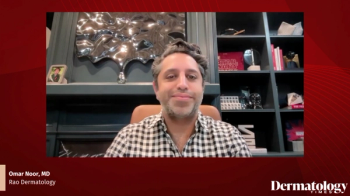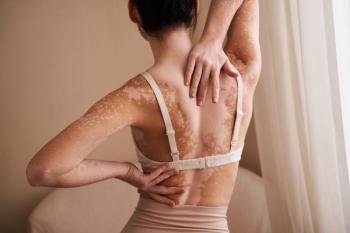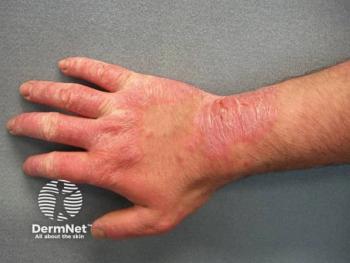
Chronic Hand Eczema or Something Else? Adam Friedman, MD, FAAD, Shares Diagnostic Tips for Differentiating
Key Takeaways
- Chronic hand eczema is a complex spectrum, often overlapping with conditions like psoriasis, ACD, ICD, and AD, complicating diagnosis.
- Patient history is crucial for differential diagnosis, focusing on recurrence patterns and potential occupational or personal triggers.
Adam Friedman, MD, FAAD, breaks down how to differentiate chronic hand eczema from similar conditions using history, morphology, and key clinical clues.
When it comes to chronic hand eczema (CHE), diagnoses and misdiagnoses can be deceptively complex. At the 2025 Society of Dermatology Physician Associates (SDPA) Annual Summer Dermatology Conference in Washington, DC, Adam Friedman, MD, FAAD, spoke in a lecture titled "Can’t HANDle it?: Tips to Optimize the Diagnosis & Management of Chronic Hand Eczema."
In a follow-up interview, Friedman, chair of the department of dermatology at George Washington University of Medicine and Health Sciences in Washington, DC, offered insight into how clinicians can distinguish CHE from mimicking dermatoses like psoriasis, allergic contact dermatitis (ACD), irritant contact dermatitis (ICD), and atopic dermatitis (AD), all of which can frequently overlap on the hands.
The Diagnostic Challenge: A Spectrum of Disease
“I think chronic hand eczema is a spectrum, which is one of the reasons why I think it’s so complicated when it comes to even making the right diagnosis,” Friedman explained.
Because hand eczema can result from or coexist with a wide range of etiologies, clinicians must think broadly when considering differential diagnoses. Friedman urged providers to be mindful not only of common culprits like AD and ICD, but also of less common conditions that may mimic eczema.
“You have to think about secondary syphilis, pagetoid reticulosis, lichen planus, and there are many others,” he said.
Among all the possibilities, he noted that psoriasis may be the most difficult to differentiate.
History Comes First
With so much diagnostic overlap, Friedman emphasized that the patient's history is crucial to differential diagnoses.
“It comes down to history,” he said. “Asking the right questions, getting to the meat of: What is the recurrence rate? What are associations temporally in terms of, whether it be occupation or things someone does at home?”
By definition, CHE must persist for at least 3 months and often involves flare-recurrence patterns.1 Understanding what triggers or worsens symptoms, whether it be chemical exposures at work, household chores, or personal care products, can point the clinician in the right direction.
Morphologic Clues: What to Look For
When examining the hands, Friedman recommended a close look at lesion distribution, morphology, and the presence of other disease elsewhere on the body.
For psoriasis, he suggested:
- Check for involvement elsewhere: scalp, ears (especially the conchal bowl), inframammary folds, or groin.
- Nail changes such as pitting, onycholysis, or oil spots are strong indicators of psoriasis.
- Palmar psoriasis tends to be more well-demarcated and frequently affects pressure-dependent areas like the thenar eminence.
“Palmar psoriasis tends to be more demarcated, having a preference for the more pressure-dependent areas,” he explained.
For eczema variants (AD, ACD, ICD):
- Lesions are typically more confluent.
- Often involve the distal fingertips and pulps.
- Less well-demarcated than psoriasiform plaques.
“It’s usually not that well demarcated as compared to psoriaform things,” Friedman said.
One additional diagnostic tip centered around lichenification: a hallmark of chronicity.
“The chronicity should also lend itself to having some lichenification, increased skin markings, and that could be a helpful clue because you will not see that when it comes to psoriasis,” Friedman added.
Friedman emphasized that hand dermatitis is not only common but also causes significant discomfort, social embarrassment, and occupational disruption. Accurate diagnosis drives treatment decisions, including topical or systemic anti-inflammatory agents, patch testing for allergens, or even lifestyle modifications for irritant avoidance.
Reference
- Silverberg JI, Guttman-Yassky E, Agner T, et al. Chronic hand eczema guidelines from an expert panel of the International Eczema Council. Dermatitis. 2021;32(5):319-326.
doi:10.1097/DER.0000000000000659
Make sure to keep up to date with the latest in coverage from the conference and subscribe to Dermatology Times to receive daily email updates .
Newsletter
Like what you’re reading? Subscribe to Dermatology Times for weekly updates on therapies, innovations, and real-world practice tips.



















